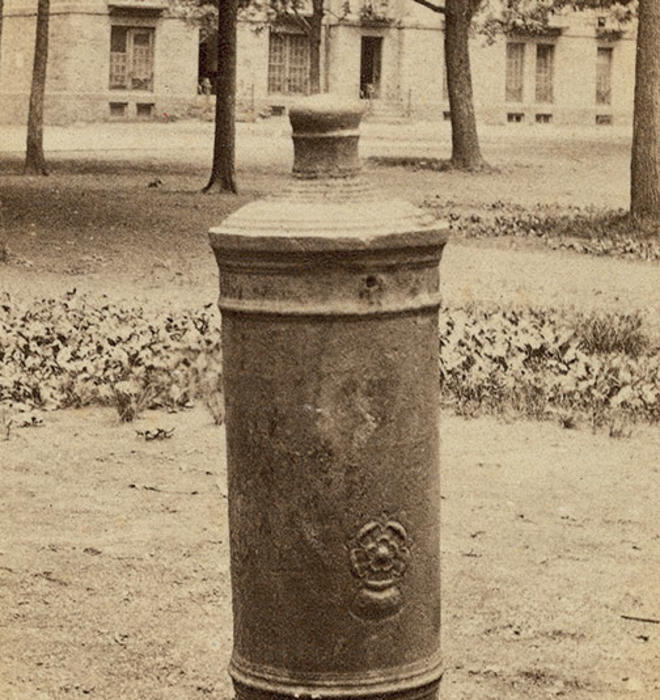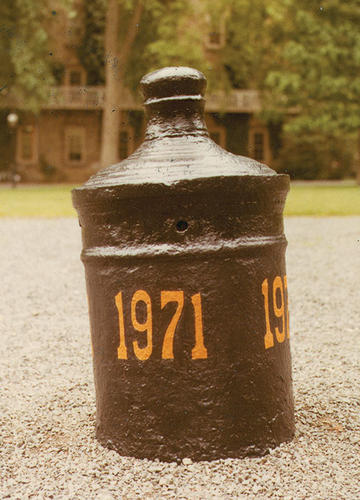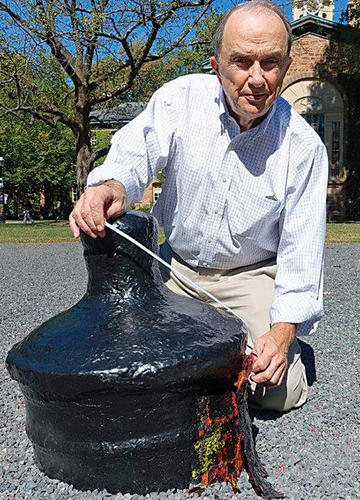
Thousands of Princeton alumni at Reunions this month will barely notice it as they walk by: the iron cannon, half-buried 175 years ago behind Nassau Hall, called our “Great Totem” by commentators for more than a century. What’s the story of this icon, which gives its name to Cannon Green?
Tradition long has held that the cannon was involved in the Battle of Princeton; the centennial of the battle was celebrated in a tent erected over the great gun. Princeton bristled with artillery in January 1777, the British having fortified the place to prevent Gen. George Washington from advancing north to New York. The handrawn “Spy Map” that came into Washington’s hands — with information from an unnamed Princeton student who had observed British positions — shows rows of cannons in the middle of Nassau Street, facing west, and more guns pointing down Witherspoon Street.So Princeton was a veritable fortress. And when the Continental Army smashed the Redcoats in the battle that saw its final phase around cannonball-scarred Nassau Hall, the British fled in disarray, leaving some artillery behind, as Washington’s official report implies.In fact, there were three cannons on the Princeton campus in the decades right after the war: the Big Cannon on today’s Cannon Green, the Little Cannon by today’s Whig Hall (not so little, really; it is said to weigh 1,000 pounds), and a third, long-vanished gun. (No one knows where that one sat.)
How old is Big Cannon? Glass-plate photographs from the 1870s show a Tudor rose and crown on the barrel and details of ornamental rings. These, along with the precise shape of the knob at the top (the cascabel), point to the cannon being a British Army weapon already venerable at the time of the Revolutionary battle.
After studying the old photographs, English ordnance historian Charles Trollope says that the gun was made in the 17th century, possibly around 1670, making it one of the oldest weapons on display in the United States.
In the decades after the Revolution, Cannon Green was the undergraduates’ own playground on a campus sternly ruled by the academic authorities. Gradually the wooden carriage of Big Cannon rotted, and the huge gun lay in the weeds. It was used as the backboard or “bucking place” when students played their favorite ballgame, “shinny,” a simple version of hockey.
When the cannon was hauled off to New Brunswick to serve as a defensive weapon in the War of 1812, Tigers never forgot the loss, and on July 4, 1836, they cheered the news that a local militia company, the Princeton Blues, had gone to bring the gun back. But the groaning conveyance carrying the monster weapon collapsed outside of Princeton village, and there our cannon lay in the dirt.
Two years later, Leonard Jerome 1839, the American grandfather of Winston Churchill, organized 100 undergraduates to load the cannon onto a wagon. In the middle of the night, they dumped it in front of Nassau Hall, at which an irate John Maclean Jr. 1816 came sprinting over in dressing gown and slippers.
Only Jerome was there to hear his protests, all the others having fled. “As it has taken 100 men two hours to load [the cannon],” Jerome explained, “I don’t see exactly how I am to load it up again all by myself.” No one has removed Big Cannon from campus since.
In 1840, other students buried the cannon muzzle-down behind Nassau Hall, where it remains. Trees there consisted only of “a few little switches struggling for life in a dusty plain with the cannon in the middle,” an alumnus recalled in 1845, but those saplings soon grew large. Most were cut down to create verdant Cannon Green in 1902, with the gun its centerpiece.
Why the cannon was buried remains unclear — perhaps to discourage its removal by college authorities or others, perhaps to hide a broken muzzle (the gun is said to have burst upon being fired one last time, while lying flat in 1836). It was not sunk very carefully; it always has leaned slightly, and freshmen were sometimes made to pull on it in a vain effort to straighten it.
It was here that the earliest games of football were organized, a soccer-like game using a cow’s bladder. “Some fine winter evening the ball would be put in play at the Cannon,” an alumnus recalled of 1844, with East and West Colleges set as the goals. In one episode around 1860, a freshman kicked a football from the gun clear over West College. Princeton pioneered intercollegiate football in 1869, a great American pastime that arguably was born around our cannon.
When cross country running became popular later in the 19th century, the race invariably started at Big Cannon. And as Princeton baseball and football increasingly drew national attention, enormous victory bonfires were held there. A December 1893 fire featured a 30-foot-tall pile of logs slathered with tar, which 2,000 spectators cheered.
In the 20th century, fires were lit only when Princeton surpassed both Yale and Harvard in football, a custom that continues today. But 19th-century students lit fires at the cannon on any possible occasion, from the arrival of President James McCosh in 1868 to the celebration of national election victories. A cry of “Fresh Fire!” brought undergrads pouring out of their dormitories on fall nights, because it meant the new students had evaded the sophomores who stood guard by the cannon and had lit a blaze to burn off its coat of green paint, which mocked the freshmen each year.
The diary of Telfair Hodgson 1859 recalls various scenes around the half-buried gun: undergrads gathered for “horn spree,” preparing to make wild noise around the campus; the “blinding glare” created by a fire after the election of James Buchanan as U.S. president; the way seniors one spring “pulled down shanties and made fires in the campus, got drunk and danced like a set of demons around the cannon.”
The administration’s official rules of 1860 outlawed, to no avail, “kindling of bonfires, and disorderly gatherings on the college grounds.” Among the most violent of annual rites was Cannon Rush, with sophomores clinging to a leather belt and ropes attached to the gun as freshmen charged them.
The best-known undergraduate ritual around the cannon was Class Day, for which the audience was so large that in the 1880s, a temporary, 2,000-seat wooden amphitheater was erected. Here, too, the cannon defined a student-friendly zone where strict Victorian-era rules were loosened: Undergraduates delivered satirical orations that ridiculed the professors. At the end, students smashed the clay pipes all were smoking against the cannon, painted black for the occasion with the class year in gold.
As national attention was focused on romantic Princeton in the 1890s, an outpouring of collegiate literature from books to magazine articles focused on the cannon. There emerged Cannon Club on Prospect Avenue, the “Cannon Song,” even a silver cannon spoon from Bailey Banks & Biddle.
Princeton’s smaller cannon, too, has received its share of attention. Rutgers students stole the relatively portable Little Cannon one moonlit night in 1875, kicking off the “Cannon War,” which McCosh called the mightiest contest since the Trojan War.
The smaller gun had been a feature of Princeton life for decades, routinely fired on the Fourth of July. Briefly it was removed to serve as a post at the corner of Witherspoon Street, but the Class of 1859 indignantly dragged it back to the College and buried it muzzle-down. Its theft by Rutgers led to reprisals and outrage, all reported by newspapers nationwide, and finally to its return to the earth of Princeton in May 1875. “The cannon is back,” McCosh said. “The campus would not have been a campus without it.”
Why not attempt to dig up Big Cannon next time, asked the Class Day orator mockingly; if that proved too heavy, Rutgers could always take “a stuffed snipe from the museum” in Nassau Hall.
The Cannon War lives on: In 1969, Princeton pranksters tricked authorities into thinking Little Cannon had again been stolen, a famous hoax; even now, the large cannon regularly is splashed with Rutgers Red by nocturnal invaders.
Reunions attendees might want to take a good look at Big Cannon this year. It’s sinking: Originally sticking about six feet out of the earth, only about two feet are visible today.
W. Barksdale Maynard ’88 lectures at Princeton and is the author of seven books, including Woodrow Wilson: Princeton to the Presidency, Princeton: America’s Campus, and, most recently, The Brandywine: An Intimate Portrait.
Rally ’Round the Cannon: The Mystery of Cannon Green
For the Record
This story has been revised. John Maclean Jr. 1816 was the College’s vice president at the time of the cannon incident involving Leonard Jerome 1840.








1 Response
Renee Samuels
4 Years AgoAnother Telling of the Cannon Story
I am reading The Fabulous Leonard Jerome, by his great-granddaughter Anita Leslie. In it the story about the cannon being dropped on the lawn says Mr. Julick, who owned the horses and wagon, is the one who said, “It’s taken 100 men two hours to load it so I don’t see how I am to load it again myself.” Jerome and the other young men had all run away when Johnny showed up.